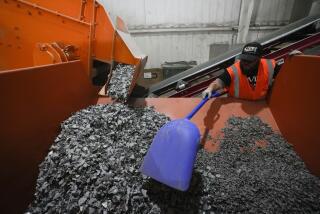Breakthrough could double solar energy output
A new discovery from a chemist at the University of Texas at Austin may allow photovoltaic solar cells to double their efficiency, thus providing loads more electrical power from regular sunlight.
Not only that, but it’s way cheap. Chemistry professor Xiaoyang Zhu and his team discovered that an organic plastic semiconductor could double the number of electrons harvested out of one photon of sunlight. Yep, plastic.
For the Record, 12:15 p.m. Dec. 19.: An earlier version of this online article incorrectly said Queen’s University is in Toronto. It is in Kingston, Ontario.
An issue with regular photovoltaic panels is that much of the energy delivered by sunlight comes in the form of “hot” electrons, which are too high-energy to be converted to electricity in silicon and are instead lost as heat. For that reason, the max insolation-to-electricity efficiency of a silicon solar cell used today is considered to be about 31%. Capturing those hot electrons could boost it to 66%.
Zhu’s process involves absorbing the photon of sunlight in a plastic – in his experiments, pentacene – to produce a dark quantum “shadow state” from which two electrons can be retrieved, instead of just one.
Right now, his experiments use ordinary sunlight, and not focused sunlight, and he’s getting 44% efficiency. That’s a big boost in electricity, and it means it could be done with ordinary rooftop panels.
Breakthroughs in the solar industry seem to be coming fast of late. Just two weeks ago we heard about researcher Douglas Keszlar at Oregon State University in Corvallis, who is studying the photovoltaic potential of fool’s gold– pyrite – and discovered instead that some more ordinary materials could make improved photovoltaics, especially iron silicon sulfide. Once again, the advantage would be that it’s hyperefficient and cheap.
All of this goes to reinforce a recent study by Joshua Pearce at Queen’s University in Kingston, Ontario, who found that cost estimates for solar technology used by energy analysts are greatly inflated. The technology is changing so fast that many studies don’t reflect the newest realities. For instance, the cost of solar panels has dropped 70% since 2009, and their productivity only declines 0.1% to 0.2% per year, rather than the 1% per year that was the norm.
The bottom line? Commonly used studies have listed dollars-per-watt of electricity as high as $7.61. According to Dr. Pearce, the real cost in 2011 is under $1 per watt.
RELATED:
Lawsuit challenge animal enterprise terror law as unconstitutional
Fracking rap video named one of best of 2011
Bird advocates urge mandatory standards for wind energy projects




